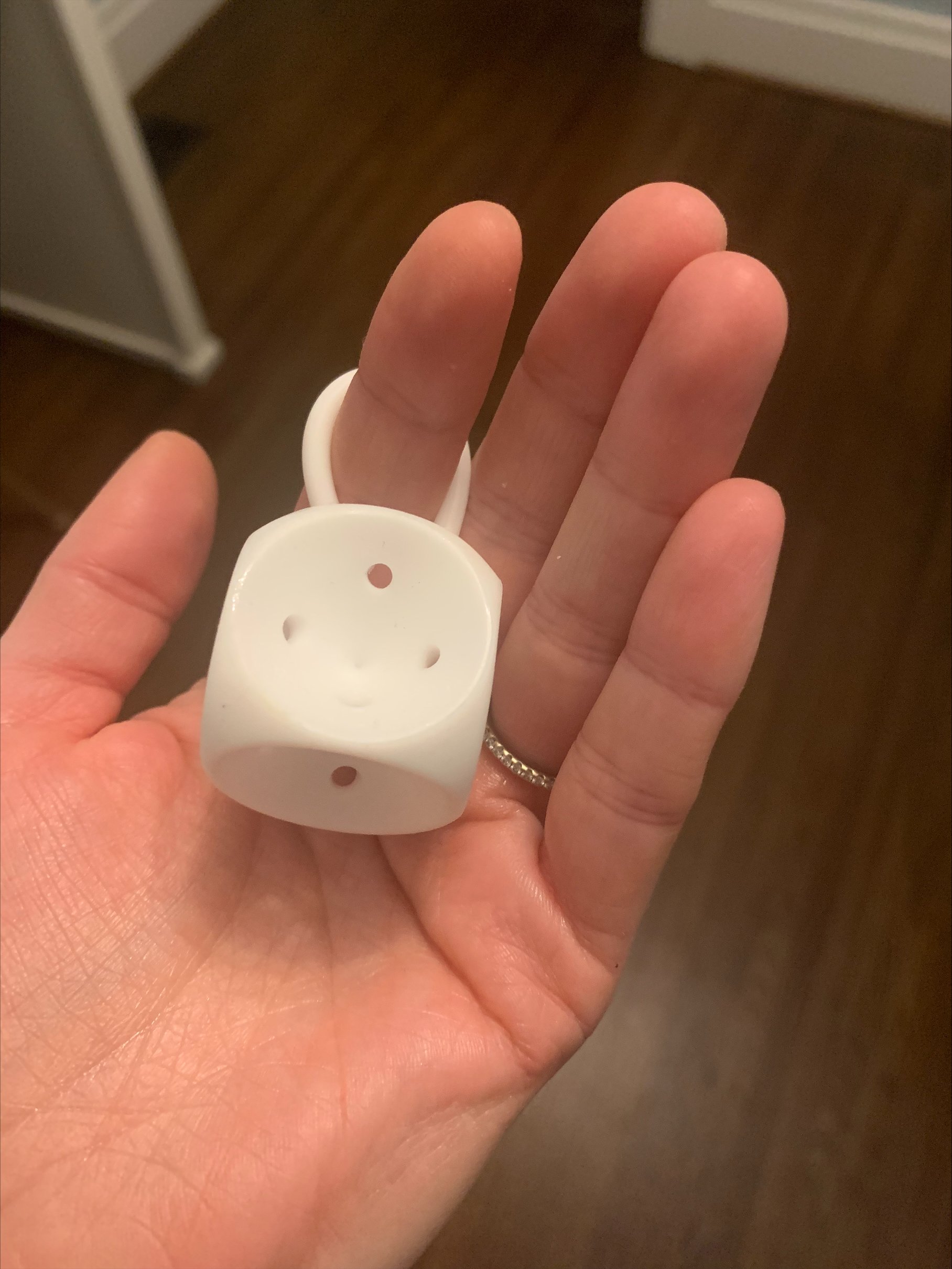What is a pessary?
In my last blog post, we learned all about pelvic organ prolapse. Now, we are going to discuss one way to treat prolapse!
A pessary is a medical device used inside the vagina to support your pelvic organs….sort of like a sports bra in your pelvis!
They also can be used for stress urinary incontinence. This is urine/pee leaks when you do things like jump/run/cough/sneeze.
As discussed in the last post, prolapse occurs due to changes in the connective tissue that holds the organs in place.
A pessary is meant to support connective tissue that is no longer doing its job well. It's sort of like the connective tissue was once the taut rubber band in the pack and is now the stretchy one. The stretchy tissue lets your organs, like the bladder, shift towards the vaginal canal.
Are there different types of pessaries
There are many types of pessaries! Let’s start by looking at two broad categories:
Space Saving Pessaries
Space Occupying Pessaries
Space saving pessaries fit between the front and back wall of the vagina like a slice of cheese between two slices of bread.
Let’s look at a picture of how this would be inside the body:
When a space-saving pessary is used, the person can typically do things like insertional sex with the pessary in place.
Examples of common types of space saving pessaries are:
Ring: Typically used for front of the vaginal wall movement (bladder prolapse) or uterus shifting down. They depend on your pelvic floor muscles to stay in place. That means they will not work if you have a wider space between your muscles.
Dish: Can be used for bladder or uterus support
Both types can have an area that is a little thicker that helps keep the urethra supported to prevent pee leaks
Here is a video of what those look like:
Space occupying pessaries take up space in the vaginal canal and keep it open. This means that when they are inserted you can not insert anything else into the vagina.
Examples of space occupying pessaries are:
Gellhorn: Used for advanced grades of uterine or bladder prolapse. It can be challenging to insert/remove and is not typically self-managed. You would need to see a provider who has extensive experience with this type of procedure for fitting.
Cube: This can be used for prolapse at the front, top, and back walls. It suctions in place, which means it might work if you have a wider space at the pelvic floor muscles due to injury during birth.
Doughnut: Like a thick version of the ring.
Here is a picture of a cube pessary:
How do you get a pessary??
A provider who has been trained to fit the pessary should help you decide what pessary will work best for your body and life.
Typically, this is either a:
Urogynecologist
OBGYN/Midwife
Pelvic Floor Therapist
They will take some measurements outside and inside of your body with a centimeter stick and their fingers to assess your anatomy. They are looking at how much movement you get at the front/top/back of the vaginal canal, the width of the hole between the sides of your pelvic floor muscles (aka the hiatus). This will help them decide what type of pessary could work.
You will have input on:
Your comfort inserting and removing the pessary.
What you want the pessary to do. AKA stop pee leaks or reduce heaviness
If you are hoping to leave the pessary in for sex
How often you ideally would need to remove/insert the pessary
After deciding what type of pessary might work your provider will insert the pessary into your vagina.
Then you will test the pessary by:
Urinating: you want to make sure you can get pee out with the pessary in place
Not feeling it: once it is in place, it shouldn’t feel bothersome or crampy. It should stop the feeling of heaviness/something falling out of your body. It may not change the actual bulge that some people are able to see.
Lifting things/jumping/running: testing if your symptoms are managed while doing activities you want or need to do
Can remove and insert the pessary on your own (if your plan is self-management)
How do I take care of my pessary?
I fit pessaries that are only self-managed and refer to a urogynecologist for those folks who require assistance to manage the insertion/removal of their pessary.
This means that we will practice inserting and removing your pessary at the fitting until you feel confident that you can do so easily.
We will decide on a safe plan for removing and cleaning your pessary. This will depend on how healthy your vaginal tissue is, what you are using the pessary for, if needs removed for things like sex, and your schedule.
Clients often remove and clean their pessary nightly and re-insert in the morning.
To clean the pessary, you will wash with warm water and a soap that is not scented or colored. It also cannot be antimicrobial/bacterial. We want to keep the microbiome of your vagina as happy as possible to prevent infections. Using an antibacterial soap to cleanse your pessary means when you insert the pessary it could kill off some of the good bacteria growing in the vagina.
What risks are there to wearing a pessary?
Typically, risk of pessaries causing serious injury or concern are low when people stick to the appropriate wearing schedule and have their tissue health checked.
Most commonly, people report increased discharge (this is normal), but there is also an increased risk of bacterial vaginosis. Any time there is smelly or discolored discharge, the pessary should be removed, and the health care provider notified of the change.
If you are post menopause more caution is needed to ensure your vaginal tissue is healthy enough to have a pessary inserted. This helps avoid things like bleeding, injury to the tissue, and the pessary making a fistula or hole between the vagina and the rectum or bladder. Often, you will require the use of a topical estrogen to get the tissue healthy enough to insert a pessary.
If you have a history of surgery where mesh is implanted into the pelvis, it is likely not safe to use a pessary.
You should replace your pessary at the manufacturer’s recommendation, often 1 year of use.
You should see your OBGYN yearly for exam of your vaginal tissues.
In the 2022 article about the self management of vaginal cube pessaries they were found to be safe and effective with minimal adverse side effects.
Will the pessary change my prolapse or is surgery the only option?
Research shows that pessaries may help reduce the size of the genital hiatus (the space between the pelvic floor muscles at the front of the pelvis) and the significance of the prolapse. This is exciting because pessaries might be a treatment rather than just a conservative strategy.
Surgery is still a viable option and I do not want to give the impression that it should not be considered.
Can I just buy a pessary at the store?
All of the pessaries discussed above require you to meet with a medical provider to be fitted. However, there are over-the-counter forms of pessaries. These include:
Impressa: looks like a tampon. Single use. Up to 12 hours of wear. Used for stress urinary incontinence.
Revive: inserted with a tampon-like applicator. Soft silicone rings with a replaceable string. Can reuse with replaced strings. Used for stress urinary incontinence.
Uresta: looks more like a plug shape of medical grade material. Can be reused for up to 1 year, daily removal recommended. Used for stress urinary incontinence.
There are exciting developments in 3-D printed pessaries…stay tuned for the future!
I don’t want to insert anything, is there another option?
Yes!!
External support garments can be a great option if you can not wear a pessary or want extra support. Examples of these include:
SRC shorts/undies: These provide medical grade compression to the perineum to help with the heavy feeling
My Pelvic Bra: Thong medical grade compression for the perineum.
It’s You Babe, V2: A thong like device for perineal compression.
Refer back to my prior post on prolapse if you want to gain a basic understanding of types or book to evaluate if a pessary is a good option for treatment!
References:
Nemeth, Z., Kolumban, S., Schmidt, R., Gubas, P., Kovacs, K., & Farkas, B. (2022). Self-management of vaginal cube pessaries may be a game changer for pelvic organ prolapse treatment: A long-term follow-up study. International Urogynecology Journal, 34(4), 921. https://doi.org/10.1007/s00192-022-05287-2
Jones K, Yang L, Lowder JL, Meyn L, Ellison R, Zyczynski HM, Moalli P, Lee T. Effect of pessary use on genital hiatus measurements in women with pelvic organ prolapse. Obstet Gynecol. 2008 Sep;112(3):630-6. doi: 10.1097/AOG.0b013e318181879f. PMID: 18757662.





